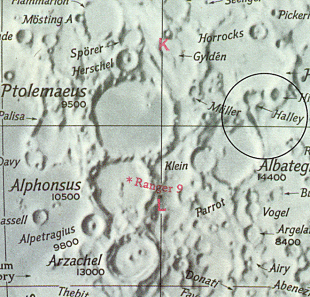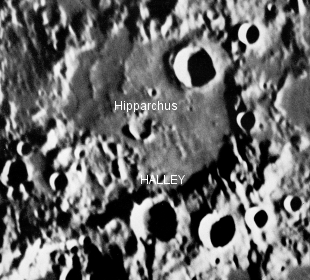

Halley Sunrise Ray (as reported by Akkana Peck )
In the same general area as Burnham, the crater Halley also exhibits a sunrise ray. The Halley ray seems to be a very short-lived phenomenon (it disappeared ten minutes after I first saw it on May 13, 1997 at about 8:10-8:15pm PDT, though I have no way of knowing when the ray first appeared since it was already well underway by the time I noticed it).
I observed the Halley Ray again on July 11, 1997 at about 9:15pm PDT. (The prediction for the Burnham Ray that night had been approximately 5pm.) Find Halley on the border between Albategnius and Hipparchus, the last and largest in a smooth arc of four or five craters of steadily increasing size which terminate at Halley (all of which will be lit except Halley, when the ray is occurring). The floor of Halley was dark except where it was bisected by a thick ray of light.
The initial event took place on May 14, 1997 at 3:10 UT date and time. The solar altitude at the time of this event was +0.469 degrees rising. The event was seen again on July 12, 1997 at 4:15 UT date and time. The solar altitude at the time of this event was +1.931 rising. Checking with the Guide software package, it was verified on the 2nd observation that the crater was farther from the terminator than was the first observation. To compute the predictions, I am going to use the first set of observation parameters which gives a lower solar altitude. The observing coordinates are about 122.3W and 37.6N. Lunar Observer's Toolkit gave the resulting initial observation using these inputs:
Site Longitude = +122.300
Site Latitude = +37.600
Site Elevation = +100.000
Feature = Halley
Feature Longitude: = +5.700
Feature Latitude: = -8.000
Reproducing Lighting For: 1997/5/14 at 03:10 U.T.
Desired Solar Altitude = +0.469(Rising), Azimuth = +91.257
Average Co-longitude = 354.774
In the Time column, D=Daylight, T=Twilight
---- Moon's ---- -- Earth's --
Topocentric Topocentric -------- Sun's --------
UT Date Time Alt° Semi-Diam'' Long° Lat° Colong° Lat° Azim°
1997/05/14 03:10T +60.657 902.67 +2.067 +4.496 354.590 -1.310 +91.257
HALLEY, +101,-141: A bright and very distinct crater 21 miles in diameter, the largest of the rings on this portion of the border of Hipparchus. The walls are broad and terraced on the inner slopes, and are continuous except on the north-east, where a pass places the floors of Halley and Hipparchus into communication with each other. - Wilkins and Moore, The Moon, Faber and Faber, 1955

